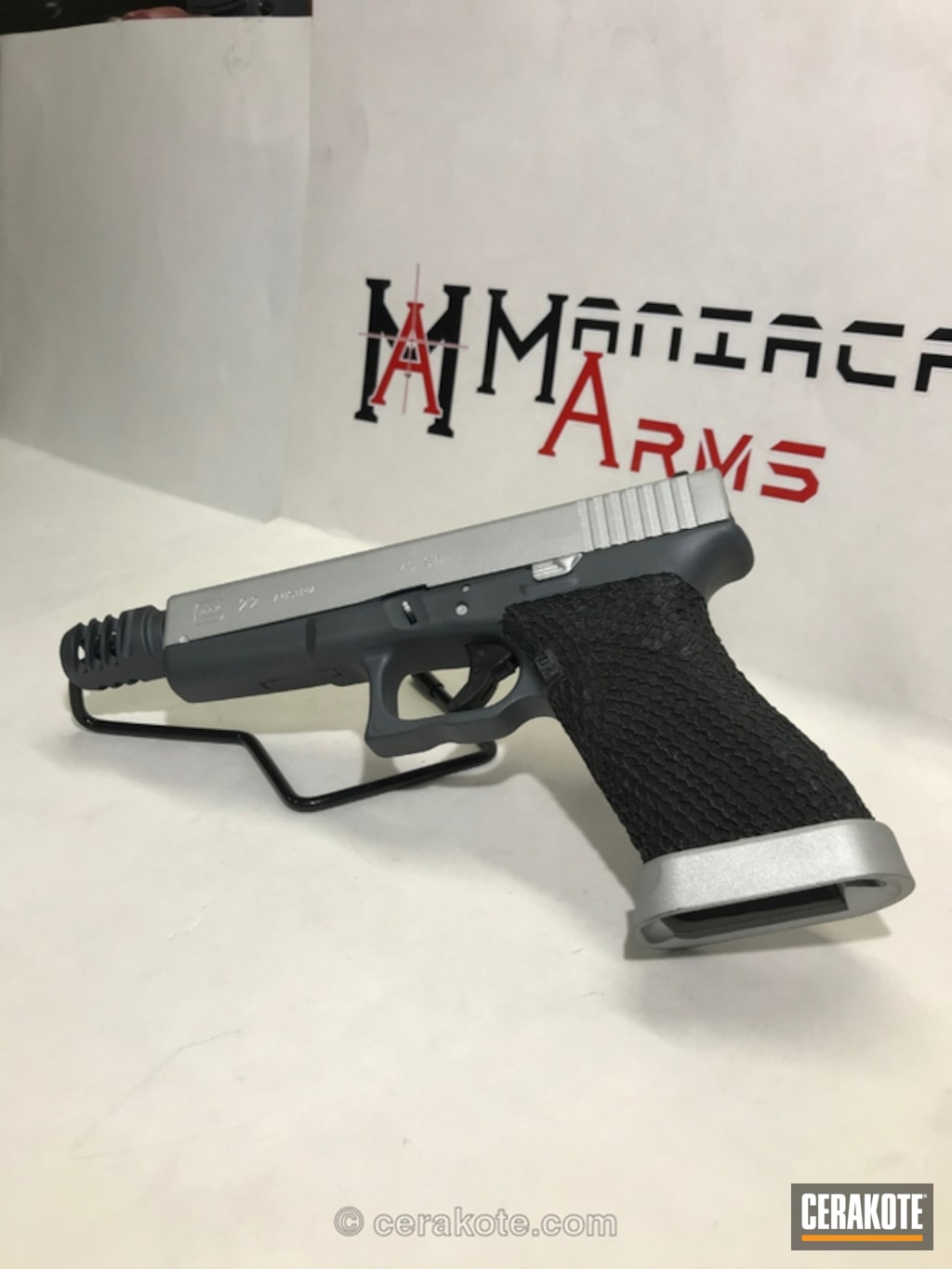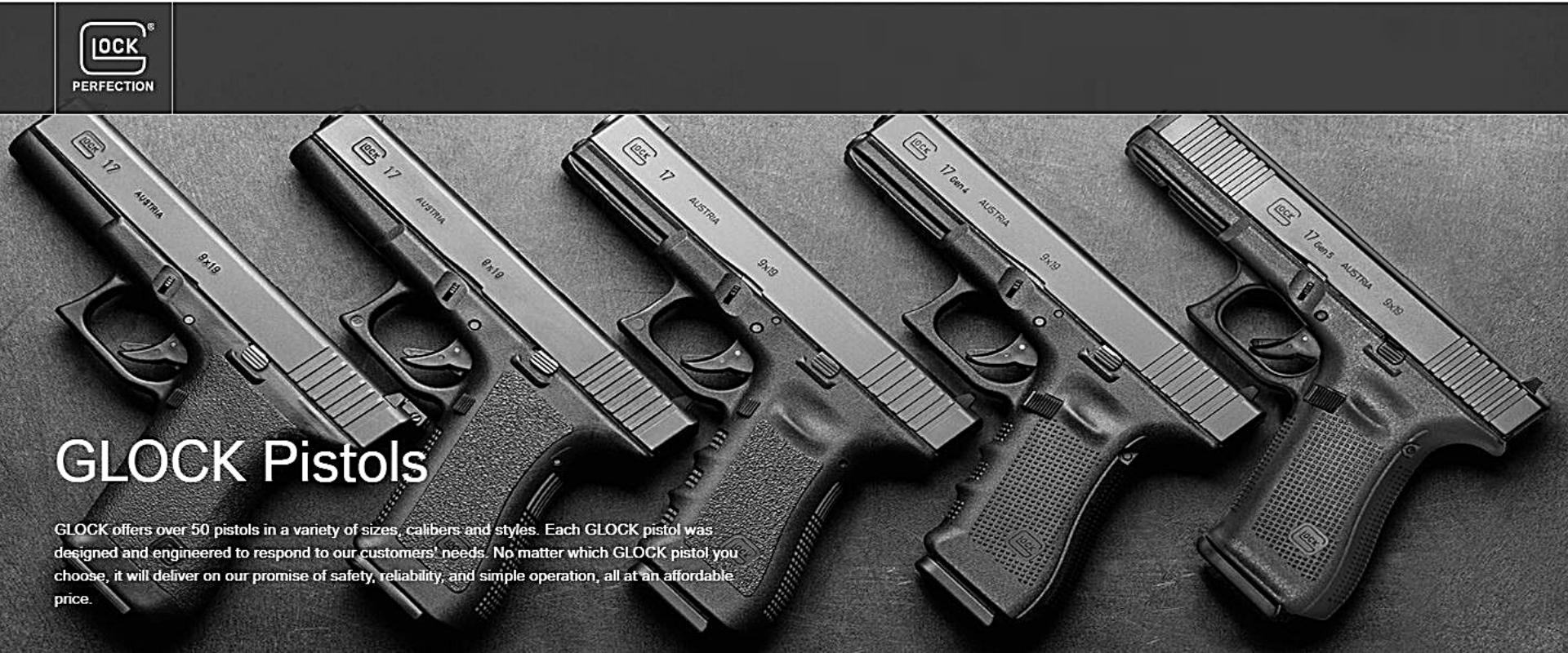Glock Generation 1 - A very common question for new Glock buyers is, "What Gen is my Glock?" Until the release of the 4th generation, Glock officially recognized nothing but model numbers, which contributed to the idea that "Glock is Glock is Glock - they are all the same." But the early collectors noticed the differences and informally settled on three main iterations, or "generations", by which they are classified. The nomenclature became so common that Glock followed suit with the Gen 4 in 2008, and their promotional literature now highlights the previous Gens in some places.
The photos below will help you determine exactly which generation your Glock belongs to, but note that there is a lot of overlap as the transition between models was slow. Also, 3rd gen pistols are still being made due to handgun restrictions in California, so you may have a 5th gen pistol that is actually older than your 3rd gen pistol! Image notes identify key features that are consistent across a generation, but slight changes in markings and internal details can be found at different intervals, and sometimes back and forth, within a single generation. Therefore, hard breaks between generations only indicate significant revisions of the frame, many parts are interchangeable between two or more, but some changes last only for a short period within a generation.
Glock Generation 1

The first generation was one of constant change. The original design, while robust, was still a work in progress. The only consistent feature is the grip texture, which covers the entire grip (no front or back strap cage). It has a smoother feel compared to later generations and has been considered by collectors to have a "pebble texture". Early rifles featured a thinner stainless steel barrel with a parker finish that was introduced at an early stage (no later than the AD prefix) and the barrel wall thickness was increased no later than the AN prefix. There are several variations in the magazine, case and small internal parts. All firearms will have Austrian proof stamps, but not the same location or number of stamps. Very early (pre-US) rifles and rifles intended for European markets do not have a serial number plate on the frame. Most early guns were also equipped with sights which became known as "weak sights" due to their fragility. Standard (fixed) sights are also period correct, although the target version will cost a premium. All frames had an embossed crescent design on the bottom of the front straps, except for the few 19's that were made.
Glock Pistols Gen3 Vs Gen4. What Is The Difference Between The Generations?
The second generation is what many novice collectors or even inexperienced dealers will refer to as the "first generation". The confusion stems from two factors: 1. The first generation is very rare and many casual observers may not have seen it before. 2. Many models were introduced in the second generation line and are considered by some to be "first generation" because this is the first release of that particular model. To clear things up, if you have a model 20 or higher, you have a second generation Glock, even if it is the first version of that gun. The obvious difference between the 1 and 2 for the 17-19 models is that a cage has been added to the front and rear straps, and the texture of the side panels has changed (deeper than the 1st generation ). Generation 2 also saw the introduction of additional 5 calibers, and all non .380/9mm guns were equipped with a second locking pin to prevent frame cracking from higher recoil. It is important to note that the number of needles does NOT indicate a generation, as many believe. 9mm frames only have two pins from Gen 1 to Gen 3, while all other calibers will have 3 pins. All full size frames are embossed with a magnetic hole at the bottom of the front strap.
By the late 1990s, Glock had become a dominant force in the American pistol market, and other manufacturers were trying to copy the design. This led to some pressure to "innovate" the Glock design to try to get ahead of the pack. Changes in the 3rd generation actually started with the release of subcompat models in 1995. It was felt that the handle would be too small for many to hold, so finger grooves were made on the front strap to try to increase purchase and prevent rotation due to recoil. This began a 3-year transition period until the full changes hit all models in '98. Some of the larger frame transitional models are quite rare (especially ported versions) - see https:///transitional/ for more information. The Gen 3 will have finger grooves on the front strap, thumb rest inlets at the top of the handle, and an accessory rail molded into the dust cover. As mentioned above, ONLY for 9mm calibers you will still find 2-pin designs during the early launch of Gen 3. In the early 2000s the frames were converted to 3-pin.
By the time the 4th generation came out, the Glock had become ubiquitous for "pistols", but once again they faced rivals with more innovative designs. One fashion trend that caught on with consumers was the availability of interchangeable straps to better adapt the pen to hands of different sizes. Glock first experimented with narrower grips in the Gen 3 SF models (they were only available in .45 and 10mm calibers). The modular strap system brought SF proportions to all frames with two size options and even beavertail dropper inserts. The internals were redesigned from the ground up and actually built with the recoil profile of the .40S&W in mind, then chambered for 9mm (where the Gen 1-3 was designed the other way around). This should make the .40 models more durable while maintaining the legendary reliability of the 9s. The texture of the grip has also changed to a more aggressive pattern on the side panels - again, this was tried for the first time in the short range of the last generation 3 guns with the so-called texture " RTF2". Technically the RTF2s are Gen 3, possibly Gen 3.5, and were only produced (except for special periods) from 2009 to 2011. See the image at the bottom of this page.
The first Gen 5 models were actually preceded by the release of the new slim subcompact models 42 and 43. These models started with a major redesign with all new interiors to accommodate the smaller size, and the FBI played a role in these changes. to the big guns with their claim to the Model M. The 19X, 42, 43, 43X, 44, 45, and 48 technically do not have the Gen 5 designation on the slide, but are still the closest match to -The other Gen 5 pistols. The 17 and 19 were officially released as Gen 5s in 2017, followed by other offerings in 9mm and .40 S&W, but no offerings of .357 Sig, 10mm, or . 45 ACP have yet to be released. Major changes of note include a "shooter" barrel, full double barrel controls, extended magwell, and removal of finger grooves on the front strap.
Glock 17 Gen1
One can find (at least) two other designs that actually fall outside the generational boundaries or are so different that they are difficult to identify from the above discourse: 1. The third generation RTF2 and 2. The FBI's M series.
RTF2 is an abbreviation for "raw frame texture, second version". The first version was only made as a prototype and was never released, although at least one is on display at the Cody Firearms Museum. The designers settled on the second version, and new shapes were made to incorporate this grip texture into the standard design of the 3rd generation. All internal parts are the same, so the only difference would be the texture of the handle. As you can see in the extended photo, the entire catch is covered in little pyramids - and let me tell you, they are sharp! This gun will really stay in your hand even when wet. Glock sold them primarily to the police from 2009 to 2011, but the design is a clear step between the third and fourth generation firearms. The pyramid concept continued, but with larger pyramids, as the RTF2 pyramids were susceptible to wear and tear as well as through clothing. See https:///rtf2g/ for more photos.
Finally, the FBI's M-series pistol is worth talking about. The 17M and 19M actually preceded and possibly inspired the Gen 5 guns. They were built to specifications requested by the FBI as the department's new service weapon and incorporated some design changes from the mini models. 42/43 as well as some new ideas. These were the first Glocks with two manual controls and rifling changes designed to improve accuracy. On the outside, however, the M pistol will look and feel almost identical to the Gen 5 - the main differences are internal, so most collectors consider them part of the Gen 5 family. However, for the right person, adding an "M" to the model designation will make a significant difference in price. , which they want

Mig 21 fighter jet, mig 35 fighter jet, mig 29 fighter jet, mig 15 jet fighter, mig 31 fighter jet, new mig fighter jet, mig 25 fighter, mig 39 fighter jet, mig jet fighter for sale, f 25 fighter jet, mig 25 jet, latest mig fighter jet